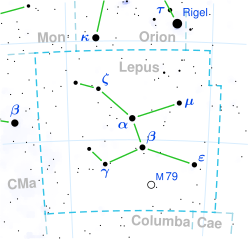Top Qs
Timeline
Chat
Perspective
Epsilon Leporis
Star in the constellation Lepus From Wikipedia, the free encyclopedia
Remove ads
Epsilon Leporis, Latinized from ε Leporis, is a third-magnitude star in the southern constellation Lepus. The apparent visual magnitude of +3.166[2] places it third in brightness among the stars in this constellation. Based upon parallax measurements, it is located at a distance of around 213 light-years (65 parsecs) from Earth.[1]
This is an evolved giant star with a stellar classification of K4 III[3] that has expanded to 40 times the Sun's radius. It is about 1.72 billion years old and has 1.70 times the mass of the Sun, with a luminosity 372[7] times as great. The outer atmosphere is cooler than the Sun's with an effective temperature of 4,131 K,[6] giving it the orange hue of a K-type star.[9] In terms of its composition, this star shows a similar abundance of elements other than hydrogen and helium to the Sun.[6]
The envelope of this star is undergoing oscillations that show up as changes in the star's radial velocity. Over long durations these follow a linear trend, in combination with shorter period oscillations occurring over a few days. These oscillations are unlikely to be the result of rotational module as that would imply a high rotation rate, which would display itself through strong X-ray emissions. Instead, they may be the result of solar-like and Mira-like oscillations.[10]
Remove ads
References
Wikiwand - on
Seamless Wikipedia browsing. On steroids.
Remove ads

